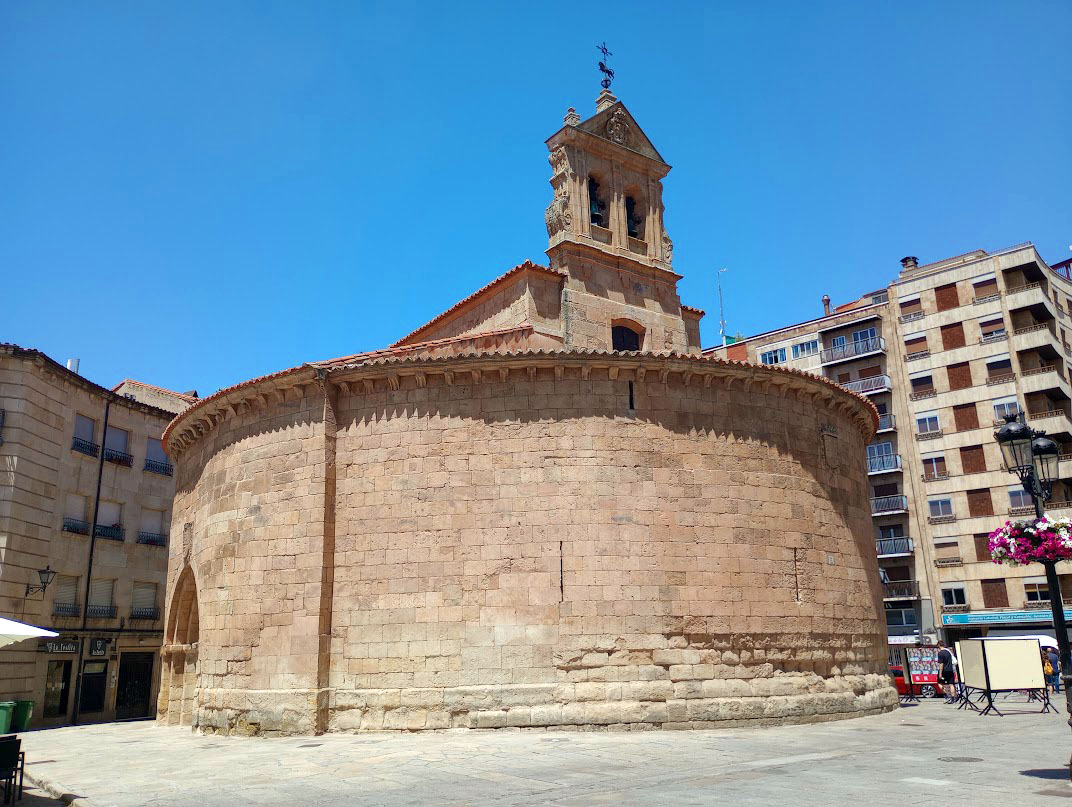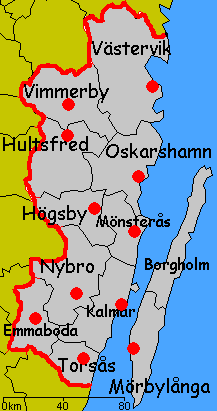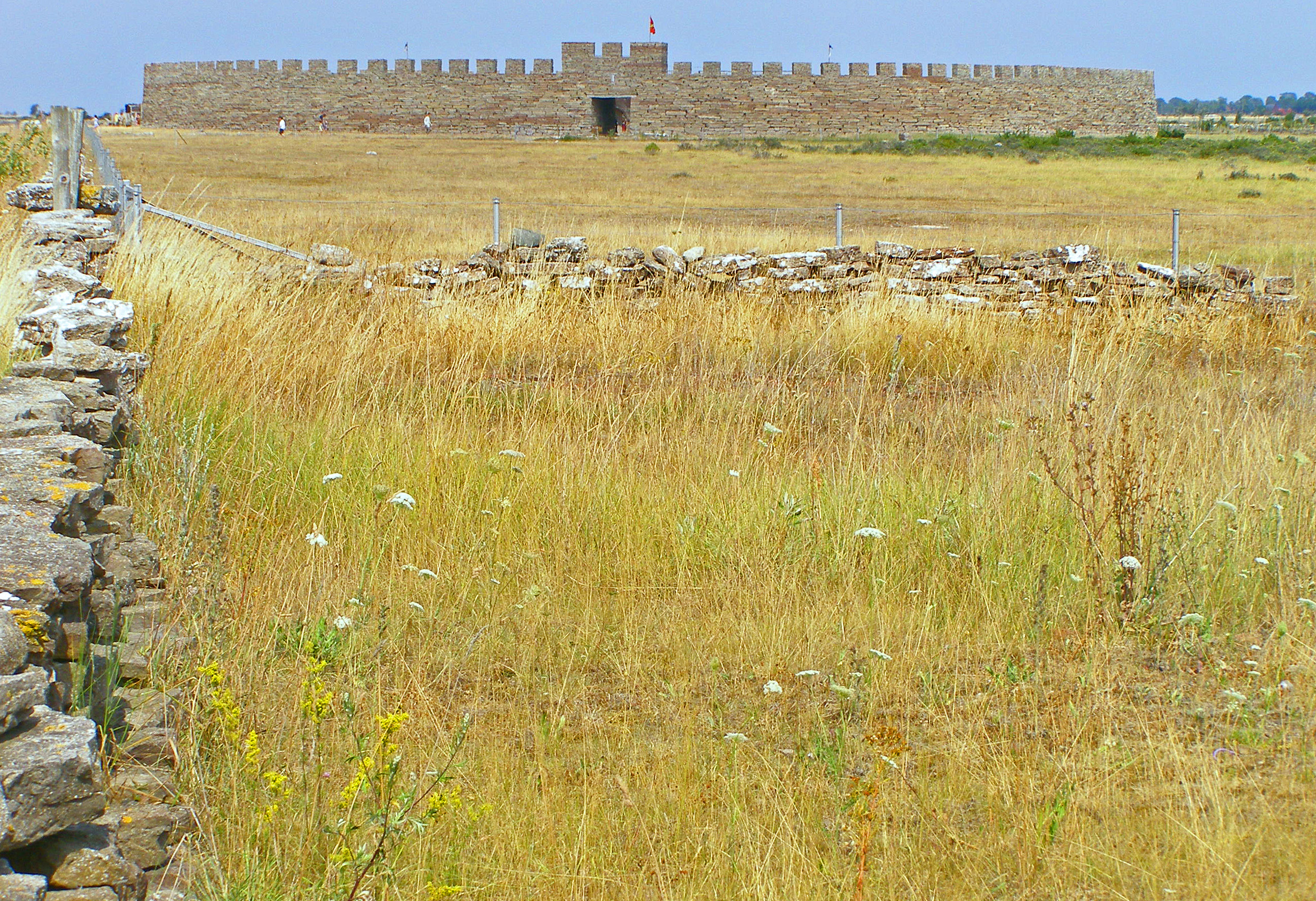|
Voxtorp Church, Kalmar County
Voxtorp Church () is a medieval round church in Kalmar County in Sweden. It belongs to the parish of Halltorp-Voxtorps in the Diocese of Växjö. History and architecture The church was built around 1240 in tufted sandstone and cobblestone and painted with white paint. It may have been one storey higher. It is a so-called fortified church and was built to serve multiple uses. Several such churches, that could be used for many purposes as places of worship, defense and also storage were during this time built along the east coast of Småland and on Öland island. It is one of only eight medieval round churches in Sweden to survive to this day. It is located not far from Hagby Church, another round church with a similar history which probably pre-dates Voxtorp Church and may have served as a source of inspiration. The church building was altered during the 14th century, when the current choir and probably also sacristy were built. In 1667 the annular thin arch collapsed. The thi ... [...More Info...] [...Related Items...] OR: [Wikipedia] [Google] [Baidu] |
Middle Ages
In the history of Europe, the Middle Ages or medieval period lasted approximately from the 5th to the late 15th centuries, similarly to the post-classical period of global history. It began with the fall of the Western Roman Empire and transitioned into the Renaissance and the Age of Discovery. The Middle Ages is the middle period of the three traditional divisions of Western history: classical antiquity, the medieval period, and the modern period. The medieval period is itself subdivided into the Early, High, and Late Middle Ages. Population decline, counterurbanisation, the collapse of centralised authority, invasions, and mass migrations of tribes, which had begun in late antiquity, continued into the Early Middle Ages. The large-scale movements of the Migration Period, including various Germanic peoples, formed new kingdoms in what remained of the Western Roman Empire. In the 7th century, North Africa and the Middle East—once part of the Byzantine Empire� ... [...More Info...] [...Related Items...] OR: [Wikipedia] [Google] [Baidu] |
Round Church
A round church is a church with a completely circular plan, thus a rotunda in architectural terms. There are many Nordic round churches in Sweden and Denmark (notably the island of Bornholm); round churches were popular in Scandinavia in the 11th and early 12th centuries. Round churches should not be confused with the older types of round-tower church constructions. Churches with many-sided polygonal shapes (such as the 16-sided example in Richmond, Vermont, United States) are likewise colloquially referred to as 'round'. Round churches by country Armenia Zvartnots Cathedral in Vagharshapat (Etchmiadzin), often cited as the world's largest round church during its existence in the Middle Ages Bosnia Church of the Holy Transfiguration, Sarajevo Brazil Cathedral of Brasília Bulgaria Round Church, Preslav Canada * Our Lady of Victory Church, Inuvik * St. Jude's Cathedral, Iqaluit * Saint George's Round Church, Halifax Croatia * Church of Saint Vitus, Rijeka * ... [...More Info...] [...Related Items...] OR: [Wikipedia] [Google] [Baidu] |
Kalmar County
Kalmar County () is a Counties of Sweden, county or ''län'' in southern Sweden. It borders the counties of Kronoberg County, Kronoberg, Jönköping County, Jönköping, Blekinge County, Blekinge and Östergötland County, Östergötland. To the east in the Baltic Sea is the island Gotland County, Gotland. The counties are mainly administrative units. Geographically Kalmar County covers the eastern part in the Småland province, and the entire island of Öland. Culture Much of Öland's present day landscape known as the Stora Alvaret has been designated as a World Heritage Site by UNESCO. This southern part of Öland is known for a large number of rare species; early Paleolithic settlement at Alby, Öland, Alby; other prehistoric remains such as the Gettlinge Gravefield and Eketorp Fortress; and the Ottenby Nature Preserve. Administration Kalmar County was integrated with Kronoberg County until 1672. Blekinge County, Blekinge was a part of Kalmar County between 1680 and 168 ... [...More Info...] [...Related Items...] OR: [Wikipedia] [Google] [Baidu] |
Diocese Of Växjö
The Diocese of Växjö () is one of 13 dioceses within the Lutheran Church of Sweden. Its episcopal see is located in the city of Växjö. The diocese was established in the 12th century as a Roman Catholic bishopric, but was taken over by the Church of Sweden as a result of the Protestant Reformation in Sweden. The Lutheran Diocese of Växjö is situated in southern Sweden and includes most of the county of Jönköping at its north end, the southern and central parts of the county of Kalmar, the island of Öland in the east, the county of Kronoberg in the south, and a small part of the county of Halland in the west. The diocese consists of 249 parishes, and has the highest church attendance in Sweden. History Within the |
Fortified Church
A fortified church is a church that is built to serve a defensive role in times of war. Such church (building), churches were specially designed to incorporate military features, such as thick walls, battlements, and embrasures. Others, such as the Ávila Cathedral were incorporated into the town wall. Monastic communities, such as Solovki Monastery, are often surrounded by a wall, and some churches, such as Fortified Church of St. Arbogast, St. Arbogast in Muttenz, Switzerland, have an outer wall as well. Churches with additional external defences such as curtain wall (fortification), curtain walls and Fortified tower, wall towers are often referred to more specifically as fortress churches or ''Kirchenburgen'' (literally "church castles"). Most fortified churches date back to time periods in Europe that were plagued by frequent conflict, for example ones in the Dordogne region of France, fought over by France and England in medieval times, and in Transylvania, during the Ottoman ... [...More Info...] [...Related Items...] OR: [Wikipedia] [Google] [Baidu] |
Småland
Småland () is a historical Provinces of Sweden, province () in southern Sweden. Småland borders Blekinge, Scania, Halland, Västergötland, Östergötland and the island Öland in the Baltic Sea. The name ''Småland'' literally means "small lands", referring to many small historic provinces from which it was composed. The Latinized form has been used in other languages. The highest point in Småland is Tomtabacken, at 377 metres (1,237 ft). In terms of total area, Småland is similar in size to Belgium and Israel. Administration Whilst the traditional provinces of Sweden no longer serve any governmental purpose ''per se'', they do retain historical and cultural importance. The province of Småland today is divided almost entirely into the three administrative Counties of Sweden, counties of Jönköping County, Jönköping, Kalmar County, Kalmar, and Kronoberg County, Kronoberg. Some few small portions of historic Småland are situated in Halland County, Halland and Öst ... [...More Info...] [...Related Items...] OR: [Wikipedia] [Google] [Baidu] |
Öland
Öland (, ; ; sometimes written ''Oland'' internationally) is the second-largest Swedish island and the smallest of the traditional provinces of Sweden. Öland has an area of and is located in the Baltic Sea just off the coast of Småland. The island has over 26,000 inhabitants. It is separated from the mainland by the Kalmar Strait and connected to it by the Öland Bridge, which opened on 30 September 1972. The county seat Kalmar is on the mainland at the other end of the bridge and is an important commercial centre related to the Öland economy. The island's two municipalities are Borgholm and Mörbylånga named after their municipal seats. Much of the island is farmland, with fertile plains aided by the mild and sunny weather during summer. Öland does not have separate political representation at the national level, and is fully integrated into Sweden as part of Kalmar County. Administration The traditional provinces of Sweden no longer serve administrative or ... [...More Info...] [...Related Items...] OR: [Wikipedia] [Google] [Baidu] |
Hagby Church, Småland
Hagby Church () is a medieval round church in Hagby, Kalmar County in Sweden. It belongs to the Diocese of Växjö. History and architecture Hagby Church dates from the late 12th century. It was preceded by a wooden chapel dedicated to Saint Sigfrid of Sweden a few kilometres south of the present church; by 1541 it was abandoned. The present church was dedicated to Saint Olaf during the Catholic era . The church was built in a round shape to serve both a religious purpose and a defensive one, i.e. it was a fortified church. 17 arrowslits have been identified in the upper part of the wall. The interior layout has changed considerably through the centuries. Originally it consisted of two floors, a basement floor and an upper floor that served as the church proper. The present layout of the church largely dates from a renovation carried out in 1968. Inside the church, there are fragments of frescos from the 14th century on the walls. The church contains a wooden crucifix from the 1 ... [...More Info...] [...Related Items...] OR: [Wikipedia] [Google] [Baidu] |
Swedish National Heritage Board
The Swedish National Heritage Board (; RAÄ) is a Swedish government agency responsible for World Heritage Sites and other national heritage monuments and historical environments. It is governed by the Ministry of Culture. The goals of the agency are to encourage the preservation and protection of historic environments and to promote the respect for and knowledge of historic environments. In order to do this, it tries to ensure that Swedish heritage is accessible to all citizens, to spread information about that heritage, and to "empower heritage as a force in the evolution of a democratic, sustainable society". History 17th and 18th century The National Heritage Board was founded in 1630. On the 20May that year, Johannes Bureus who was a prominent rune researcher and King Gustavus Adolphus' private teacher, was appointed the first ''riksantikvarien'' ("National Antiquarian"). Bureus' teachings had made the king interested in ancient monuments and national heritage sites ... [...More Info...] [...Related Items...] OR: [Wikipedia] [Google] [Baidu] |
Choir (architecture)
A choir, also sometimes called quire, is the area of a church or cathedral that provides seating for the clergy and church choir. It is in the western part of the chancel, between the nave and the sanctuary, which houses the altar and Church tabernacle. In larger medieval churches it contained choir-stalls, seating aligned with the side of the church, so at right-angles to the seating for the congregation in the nave. Smaller medieval churches may not have a choir in the architectural sense at all, and they are often lacking in churches built by all denominations after the Protestant Reformation, though the Gothic Revival revived them as a distinct feature. As an architectural term "choir" remains distinct from the actual location of any singing choir – these may be located in various places, and often sing from a choir-loft, often over the door at the liturgical western end. In modern churches, the choir may be located centrally behind the altar, or the pulpit. The place w ... [...More Info...] [...Related Items...] OR: [Wikipedia] [Google] [Baidu] |
Sacristy
A sacristy, also known as a vestry or preparation room, is a room in Christianity, Christian churches for the keeping of vestments (such as the alb and chasuble) and other church furnishings, sacred vessels, and parish records. The sacristy is usually located inside the Church (building), church, but in some cases it is an annex or separate building (as in some monastery, monasteries). In most older churches, a sacristy is near a side altar, or more usually behind or on a side of the high altar, main altar. In newer churches the sacristy is often in another location, such as near the entrances to the church. Some churches have more than one sacristy, each of which will have a specific function. Often additional sacristies are used for maintaining the church and its items, such as candles and other materials. Description The sacristy is also where the priest and attendants vest and prepare before the Church service, service. They will return there at the end of the service to r ... [...More Info...] [...Related Items...] OR: [Wikipedia] [Google] [Baidu] |









